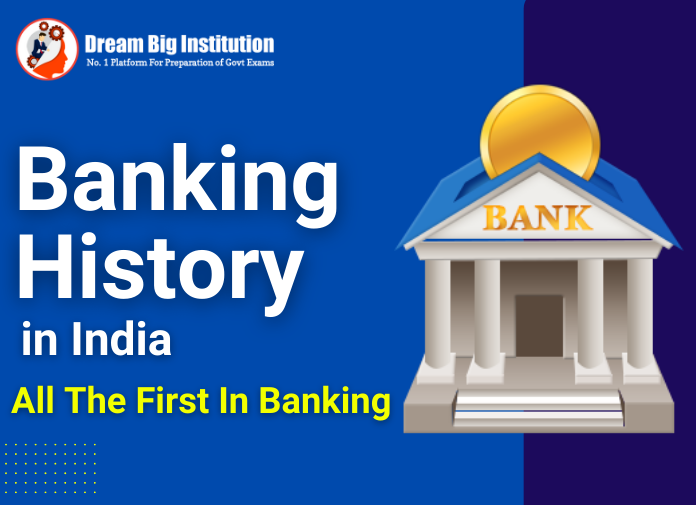Hello Dear Aspirants,
Table of Contents
Banking History in India Introduction:
Banking History in India: Banking in India has a long history dating back to the 19th century. The first bank in India, Bank of Hindustan, was established in 1770 and liquidated in 1829. The first fully Indian-owned bank, Oudh Commercial Bank, was established in 1881 in Faizabad but failed in 1958. In 1894, the Reserve Bank of India, India’s central bank, was established.
During the early 20th century, several Indian banks were established, including Allahabad Bank (1865), Punjab National Bank (1894), and Canara Bank (1906). After India gained independence in 1947, the government nationalized 14 major commercial banks in 1969 and 6 more in 1980. This helped increase access to banking services and financial inclusion in the country.
In the 1990s, the Indian government liberalized the banking sector and allowed foreign banks to enter the market, leading to increased competition and innovation in the industry. Today, India has a well-developed banking system with a large number of public sector, private sector, foreign, and cooperative banks serving the financial needs of the country’s 1.3 billion people.
Who started banking in India?
Banking in India has a long history, with evidence of lending and borrowing activities dating back to ancient times. However, the first modern bank in India was established by the British in 1786, known as the Bank of Hindustan. It was followed by the establishment of other banks such as the General Bank of India in 1786, the Bank of Bengal in 1809, and the Bank of Bombay in 1840. These banks, along with others established during the pre-independence period, laid the foundation for the growth and development of the banking sector in India.
The banking sector development can be divided into three phases:
Yes, the development of the banking sector in India can be divided into the following three phases:
- Early phase (1770-1969): During this period, the first bank was established in India, the Bank of Hindustan in 1770. Over time, several Indian banks were established, including Allahabad Bank (1865), Punjab National Bank (1894), and Canara Bank (1906). However, the banking sector remained fragmented and lacked uniformity.
- Nationalization phase (1969-1991): In 1969, the Indian government nationalized 14 major commercial banks with the objective of increasing access to banking services and financial inclusion. The nationalization of banks also aimed to bring stability to the banking sector and ensure that credit was directed to priority sectors such as agriculture and small-scale industries.
- Reforms phase (1991 onwards): In 1991, the Indian government introduced economic reforms, which included the liberalization of the banking sector. This allowed private and foreign banks to enter the market and increased competition and innovation in the industry. The banking sector has since witnessed rapid growth, with the introduction of new technology and the expansion of banking services to remote and underserved areas.
Pre-Independence Period (1786-1947):
The pre-independence period in India’s banking history, spanning from 1786 to 1947, was characterized by the establishment of several banks, both Indian and foreign, and the gradual development of the banking system. Some key events and developments during this period include:
- Bank of Hindustan: The first bank in India, the Bank of Hindustan, was established in 1770 and operated until 1829.
- English East India Company: The English East India Company established several banks, including the Bank of Bengal (1809), Bank of Bombay (1840), and Bank of Madras (1843), which later merged to form the Imperial Bank of India in 1921.
- Oudh Commercial Bank: The first fully Indian-owned bank, the Oudh Commercial Bank, was established in 1881 in Faizabad, Uttar Pradesh.
- Reserve Bank of India: In 1935, the Reserve Bank of India (RBI) was established as the central bank of India, and it played a key role in regulating the banking system and promoting financial stability.
- Swadeshi Movement: The Swadeshi movement, which was a part of the Indian independence movement, encouraged the establishment of Indian-owned banks and the use of Indian goods. This led to the creation of several indigenous banks, including the Punjab National Bank and Canara Bank.
Despite these developments, the pre-independence banking sector in India was characterized by a lack of uniformity and fragmentation, and access to banking services was limited, particularly for rural and low-income populations.
Post-Independence Period (1947-1991)
The post-independence period in India’s banking history, spanning from 1947 to 1991, was marked by government intervention and the nationalization of major commercial banks. Some key events and developments during this period include:
- Nationalization of banks: In 1969, the Indian government nationalized 14 major commercial banks with the objective of increasing access to banking services and financial inclusion. The nationalization of banks also aimed to bring stability to the banking sector and ensure that credit was directed to priority sectors such as agriculture and small-scale industries.
- Expansion of banking services: Following nationalization, the Indian government launched several initiatives aimed at expanding access to banking services, particularly in rural and underserved areas. This included the establishment of regional rural banks and the creation of a network of branches in rural areas.
- Increased government control: The nationalization of banks and the expansion of banking services led to an increase in government control over the banking sector. This resulted in a focus on priority sector lending and the allocation of credit to specific sectors, rather than market-driven lending decisions.
- Technological advancements: The post-independence period also saw the introduction of new technology in the banking sector, such as automated teller machines (ATMs) and computerization of banking operations.
Despite these developments, the banking sector in India remained dominated by public sector banks, and private sector and foreign banks continued to play a limited role. The lack of competition and innovation, combined with increased government control, led to inefficiencies in the banking sector and a need for reforms.
Current Situation Of Banks
Banks in India are Currently fairly mature in terms of supply, product range and reach-even though reach in rural India still remains a challenge for the private sector and foreign banks.
Currently, Banks in India can be categorized into Scheduled and Non-scheduled Banks-
1) Scheduled Banks
Scheduled banks are banks that are included in the Second Schedule of the Reserve Bank of India (RBI) Act, 1934. This designation is important because only scheduled banks are eligible for certain privileges and benefits provided by the RBI, such as borrowing from the central bank and accessing the payment and settlement systems.
There are two types of scheduled banks in India:
- Scheduled Commercial Banks: This category includes all commercial banks, including public sector banks, private sector banks, and foreign banks, that are included in the Second Schedule of the RBI Act.
- Regional Rural Banks: This category includes regional rural banks, which are focused on providing banking services in rural areas. These banks are sponsored by commercial banks and are included in the Second Schedule of the RBI Act.
Overall, scheduled banks play a critical role in the financial system of India, providing credit and other financial services to individuals and businesses, and contributing to the development of the economy.
We can categorize scheduled commercial banks into four types:
• Public Sector Banks
• Private sector Banks
• Foreign Banks
• Regional Rural Banks
Public Sector Banks: These are those entities which are owned by Govt. having more than 51% stake in the capital.
• Private Sector Banks: Private Banks are those entities which are owned by private individuals/institutions and these are registered under the Companies Act 1956 as Limited Companies.
• Regional Rural Banks (RRBs): These entities are completely under government and work for the betterment of the rural sector of the society.
• Development Banks: These basically include Industrial Finance Corporation of India (IFCI) which was established in 1948, Export-Import Bank of India (EXIM Bank) which was established in 1982, National Bank for Agriculture & Rural Development (NABARD) which was established in 1982, and Small Industries Development Bank of India (SIDBI) which was established on 2nd April 1990
2) Non-scheduled bank
Non- Scheduled Banks defined in clause (c) of section 5 of the Banking Regulation Act, 1949 (10 of 1949), which is not a scheduled bank”.
Reserve Bank of India is the only central bank of India and all Banks in India are required to follow the guidelines as issued by RBI.
The Firsts In Indian Banking System:
- First bank in India was Bank of Hindustan (1770)
- First Bank managed by Indians was Oudh Commercial Bank
- First Bank with Indian Capital was Punjab National Bank (Founder of the Bank is Lala Lajpat Rai)
- First Foreign Bank in India is HSBC
- First bank to get ISO certificate is Canara Bank
- First Indian bank outside India is Bank of India
- First Bank to introduce ATM is HSBC (1987, Mumbai)
- First Bank to have a joint-stock public bank (Oldest) is Allahabad Bank
- First Universal bank is ICICI (Industrial Credit and Investment Corporation of India)
- First bank to introduce saving account is Presidency Bank (1833)
- First Bank to Introduce Cheque system is Bengal Bank (1833)
- First bank to give internet banking facility is ICICI
- First bank to sell mutual funds is State Bank of India
- First bank to issue credit cards is Central Bank of India
- First Digital Bank is Digibank
- First Rural Regional Bank (Grameen Bank) is Prathama Bank (sponsored by Syndicate Bank)
- First bank to get ‘in principle’ banking license is IDFC and Bandhan Bank
- First Bank to introduce merchant banking in India is Grind lays bank
- First bank to introduce blockchain technology is ICICI
- First bank to introduce voice biometric is Citi Bank
- First bank to introduce robot in banking service is HDFC
Banking History in India (FAQ)
Q. Who started banking in India?
Ans: During the British rule in India, The East India Company had established three banks: Bank of Bengal, Bank of Bombay and Bank of Madras and called them the Presidential Banks. These three banks were later merged into one single bank in 1921, which was called the “Imperial Bank of India.”
Q. Who is the father of banking in India?
Ans: Maidavolu Narasimham
Q. Which bank came first in India?
Ans: The oldest bank in India is The Madras Bank (1683), followed by the Bank of Bombay, founded in 1720, which is then followed by the Bank of Hindustan, founded in 1770.
Q. What are the four types of banking?
Ans: The 4 different types of banks are Central Bank, Commercial Bank, Cooperative Banks, Regional Rural Banks. You can read about the Types of Banks in India – Category and Functions of Banks in India in the given link.
Thank You For Reading the Banking History in India
We hope that Banking History in India this article is useful for you, If you have any doubts or queries related to Banking History In India, Please Comment below.
Banking History in India Keep Sharing & Learning.













